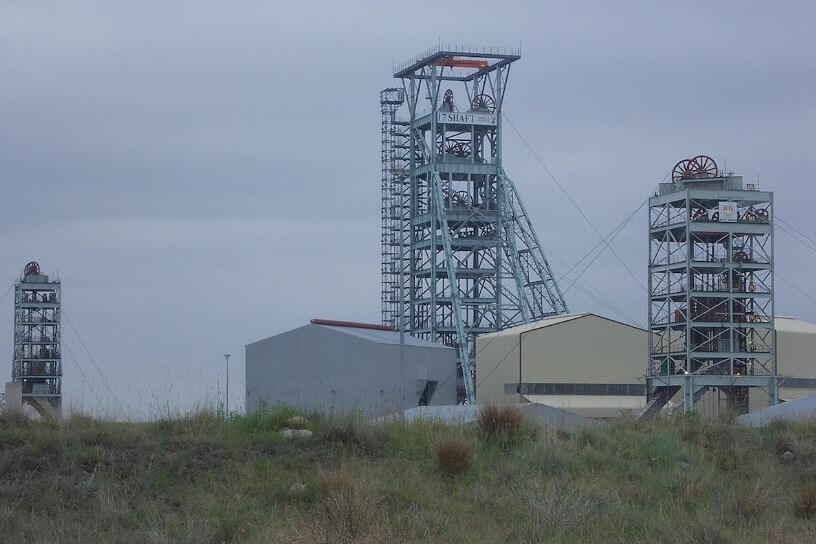The headgear of a mine is the structure that supports the hoisting rope or cable of a mine shaft. It allows for materials and people to be transported between levels within the mine. Headgears come in various shapes and sizes, but they all serve the same basic purpose. Here’s everything you need to know about what does the headgear of a mine doin South Africa.
What Does The Headgear Of A Mine Do In South Africa?
Mine headgear in South Africa plays the same essential role as it does in other parts of the world: to support the hoisting rope or cable of a mine shaft and allow for materials and people to be transported between levels within the mine.
South Africa has a long history of mining, dating back to the discovery of diamonds in Kimberley in 1866. Today, South Africa is a major producer of gold, platinum, diamonds, and other minerals. Mine headgear can be seen all over the country, from the Witwatersrand goldfields to the diamond mines of Kimberley.
South African mine headgear is typically made of steel and concrete. It is usually quite tall, with some headgears reaching over 100 meters in height. The headgear is supported by a series of columns or beams, and it is equipped with a pulley system that allows the hoisting rope to be raised and lowered.
The hoisting rope is attached to a cage or skip, which is used to transport materials and people up and down the mine shaft. The cage or skip is typically made of steel and it is equipped with safety features such as brakes and emergency exits.
Mine headgear is an essential part of mining operations in South Africa. It allows for the safe and efficient transportation of materials and people between levels within the mine. Headgears are also a symbol of the mining industry, and they can be seen for miles around many mining towns.
In addition to its essential function in mining operations, mine headgear in South Africa also plays a symbolic role. It is a reminder of the country’s rich mining heritage and the importance of the mining industry to the South African economy. Mine headgear is also a source of pride for many mining communities.
Types Of Headgears Used At South African Mines
There are two main types of headgears used at South African mines: steel headgears and concrete headgears.
Steel headgears are typically lighter and less expensive to construct than concrete headgears. They are also easier to modify or repair. However, steel headgears are more susceptible to corrosion and fire damage.
Concrete headgears are heavier and more expensive to construct than steel headgears, but they are also more durable and resistant to corrosion and fire damage. Concrete headgears are also more resistant to seismic activity.
The type of headgear used at a particular mine will depend on a number of factors, including the depth of the mine shaft, the type of materials being mined, and the seismic activity in the area.
Here are some examples of steel and concrete headgears at South African mines:
- Steel headgear: Impala Platinum’s Shaft 17 headgear, near Rustenburg, is one of the tallest steel headgears in the world, at 87 meters high.
- Concrete headgear: Impala Platinum’s No. 16 shaft, near Rustenburg, has the tallest concrete headgear in the world, at 132 meters high.
Mine headgears are an essential part of mining operations in South Africa. They allow for the safe and efficient transportation of materials and people between levels within the mine. Headgears are also a symbol of the mining industry, and they can be seen for miles around many mining towns.
Conclusion
The headgear of a mine is the structure that supports the hoisting rope or cable of a mine shaft. It allows for materials and people to be transported between levels within the mine. Headgears come in various shapes and sizes, but they all serve the same basic purpose.
In South Africa, mine headgear plays an essential role in the mining industry. It allows for the safe and efficient transportation of materials and people between levels within the mine. Headgears are also a symbol of the mining industry, and they can be seen for miles around many mining towns.
There are two main types of headgears used at South African mines: steel headgears and concrete headgears. Steel headgears are typically lighter and less expensive to construct than concrete headgears, but they are also more susceptible to corrosion and fire damage. Concrete headgears are heavier and more expensive to construct than steel headgears, but they are also more durable and resistant to corrosion and fire damage.
The type of headgear used at a particular mine will depend on a number of factors, including the depth of the mine shaft, the type of materials being mined, and the seismic activity in the area.
Mine headgears are an important part of the South African mining industry. They play a vital role in the safe and efficient transportation of materials and people, and they are a symbol of the country’s rich mining heritage.
Image Courtesy: theheritageportal
